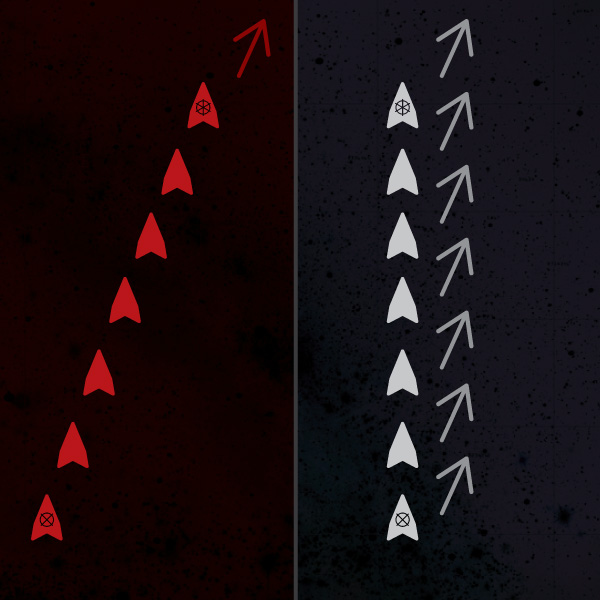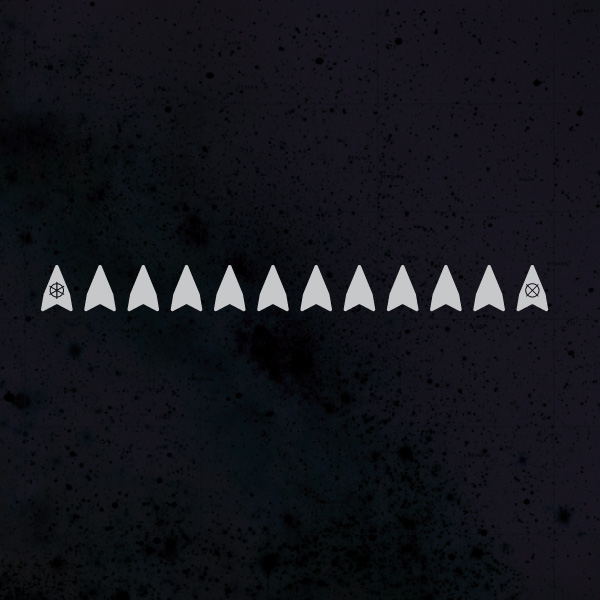
SCUL Mission Tactics
Being a SCUL starpilot means you get to fly a crazy ship with style – a controlled chaos, similar to an internal combustion engine, without the adverse side effects; depending on how many burritos you recently ate. While SCUL ship design is all over the place, the fleet is very controlled. Being in a SCUL flight formation can be exhilarating: not only does it look cool, it hones your ship-handling skills for when you need it most. At any time during a mission the navigator or the mission leader may call a command: stay vigilant!
When you hear a flight call, repeat it to others until you are sure that all pilots within earshot have heard you, and are passing the message along - this is how SCUL communicates. Assemble as quickly as possible. Maintain formation until you hear otherwise. Any pilot can call 'incoming' to override the fleet into dart formation, SCUL's defensive formation.
Maintaining Fleet Cohesion is Our Main Priority
SCUL pilots fly as an indivisible unit - we position ourselves so that there's not enough room to have transports separate us. It's every pilot's responsibility to close up gaps so we can stick together, especially in busy areas of space and near pulsars. If you are having difficultly closing the gap due to your ship's limited thrust, let the tailgunner know.Ground Formations
In order for the fleet to launch it must assemble to receive mission briefing. Ground formations happen on the launchpad, the landing pad, and during shore leave. They are the easiest formations to achieve and maintain because the fleet is stationary.Fall Ranks

Fall ranks
The navigator positions their ship closest to the exit of the launch pad, and the tailgunner goes to the opposite side, with com-sat next to them on the inside of the line, as shown in the above illustration. Pilots form as tight a line as possible so that the mission leader can be heard clearly during preflight ceremonies. Be sure to stick out your hand as the mission leader counts you, and be sure to look them in the eye at the moment of 'first contact'.
Circle Ranks

Circle ranks
For missions over 20 strong, circle rank is preferred so that folks on the fringe can hear the pre-flight briefing. Circle formation is a little trickier to perfect: try to have all pilots be equidistant to the mission leader. Note that there is one com-sat for every ten ships in the fleet, rounding up.
Standard Flight Tactics
Every SCUL starpilot is duty-bound to follow nav-tail procedures, or navigation-tailgunner protocol. The Navigator is the 'rudder' of the fleet, and the Tailgunner is controls the pace of the fleet. No one is allowed in front of the Navigator, and the Tailgunner must remain the last ship. Often the two communicate through HAM subspace frequencies, but not all navigators and tailgunners have HAM licenses - in which case we rely more heavily on a communication-satellite pilot, or com-sat monkey, to relay information back and forth. Typically the com-sat monkey positions themselves second to last next to the Tailgunner. The com-sat monkey needs to be fast and maneuverable, so they can quickly fly up and down the line to relay messages back and forth, and to the mission leader.
Clot Formation

Tighten up
The fleet often finds themselves in tight situations, particularly in constellations along busy starpaths with dense transport traffic. In order to keep pilots safe and to keep the fleet from splitting up, the mission leader may call 'tighten up!'. Get your ship into a close proximity to the others at fastest safe speed. Tighten any gaps over six feet, unless you are piloting a ship with a particularly high technical rating. The fastest way for the fleet to 'tighten up' is for the ships up front to ease up, and for the ships in the rear to 'giddy up'.
Dart Formation

Incoming
Incoming is the formation call a SCUL pilot hears the most, and it is the most important formation for a SCUL pilot to perfect. This is the only flight formation that any SCUL pilot can call. When you hear 'INCOMING!', repeat the call until you are sure everyone within earshot has heard it, as it means a transport is coming. Fall into a perfectly straight line at fastest safe speed. The most effective way to make room for ships to form a tight singe file is for the navigator to accelerate and the tailgunner decelerate. SCUL has practiced this formation for a many decades, and we have gotten so good at as to impress the transport operators.
Starboard

Starboard
Possibly the easiest of maneuvers - just follow the leader and make a right. Be sure to make way for larger vessels. For a hard right, the call is 'hard to starboard'.
Port

Port
Here is the SCUL fleet executing a left-hand turn. Be mindful of your right flank as there may be incoming transport traffic: the best way to hold them off is to flash a big smile and wave as you gracefully swoop your ship. For a hard left, the call is 'hard to port'.
Starboard Side

Starboard Side
When you hear the call 'starboard side', check your six to be sure it's clear, then move to the right lane - don't wait for the ship in front of you. When this maneuver is performed properly it makes the transport operators' eyes all buggy.
Port Side

Port Side
Typically called when the navigator is preparing to turn the fleet left. Check-six and make it happen at best safe speed.
Hard About

Hard About
We gonna turn this motha out! Make way for larger vessels with large turning radii, and be especially mindful of your surroundings.
Company Halt

Company Halt
The fleet is called to all stop. Maintain a single line in heavy transport areas and try to not get in the way. Keep it tight.
Mechanical

Mechanical
If SCUL suffers plasma containment failure or a ship mechanical, the fleet lands and gathers together as one group. Break atmo whenever possible, and avoid hanging out in the spacelane. Make way for civilians that are passing by. If the music stops, it's 'silent running', which means whispers only - we don't want to wake any babies!
Fly Casual

Clear in the Rear
Late into the mission in the wee hours, SCUL pilots get the whole spacelane to themselves. This is one of the perks of late nite missions. Fly your ship all over the place, just don't exceed the navigator of fly behind the tailgunner. Be mindful and listen for the 'incoming' call.
Single Ship Maneuvers
While SCUL flies in a controlled manner, there are some maneuvers a ship can perform without breaking protocol.
Break Atmo

Sometimes it's fun to ride up on the sidewalk, perhaps in order to crush a discarded cup, or to get a sweet high-five. Watch out for civis and steep, fork-snapping curbs.
Loop the Loop

Got some extra energy and want to 'punch it'? Check your six, then loop your ship to port, then fly your starship back into formation.
Swoopin'

Only to be performed when the space is clear of civilians and transports, and therefore is rarely seen by others. Good swooping will put a ship nearly perpendicular to the fleet at it is performed, and will even break atmo on both the port and starboard side of the spacelane.
The Fourier Effect

Since the swoop maneuver is more than a little contagious, it can spread to most or even all of the fleet. This is known as the Fourier effect, and while it is not technically a formation, it's extremely fun and worth mentioning.
Basic Formations
SCUL pilots should do their best to be able to form and maintain basic flight formations, as this is what separates us from savages.
Wall Formation

Wall formation
The most basic of the 'show formations', wall formation is typically often called after the bars close, when we have the streets to ourselves; one of the reasons we ride so late at night.
Flying-V Formation

Flying-V formation
This is a natural progression from the wall formation, and and often happens in succession, in which case the navigator falls behind and to the port side and the tailgunner on the starboard side, contradictory to the illustration.
Wedge Formation

Wedge formation
Similar to the Flying-V formation, can be used to honor or protect the innermost pilot. If our mission objective is to honor a particular pilot, the wedge formation is fitting.
Scoop Formation

Scoop formation
A 'reverse flying-v'. Can you dig it?!
Block Formation

Block formation
Occasionally the fleet is treated to being able to 'take a lane'. Note the Navigator and Tailgunner stay on the port side of the fleet: they determine the outside edge against transport traffic.
Missing Pilot Formation

Missing pilot formation
A solemn and sacred ritual, reserved to honor those who are no longer with us. This formation is performed in silence.
Intermediate Formations
These formations require some concentration and discipline, and therefore may take additional practice before perfecting.
Redcoat Formation

Redcoat [rows] formation
This formation is effective for larger fleets, when there's not enough room to form a wall. The pilot who calls redcoat formation declares how many rows to form.
Cross Formation

Cross [width] formation
The Cross formation is a holy matrimony of the dart formation and the wall formation. Odd numbers for the wall work best.
Advanced Formations
Advanced flight formations require practice. Sometimes SCUL has training exercises in a big parking lot, late at night, when no one's looking. Advanced flight formations often require the tailgunner may move in front of the navigator, which inherently breaks spacetime.
Gusher Formation

Gusher formation
The easiest of the advanced flight formations, the gusher alternates left and right where the centerline moves forward, as the outer lanes fall back. Timing is critical.
Pinwheel Formation

Pinwheel formation
The navigator creates the axis that all pilots circle around while the battalion moves forwards. Circle spins counter-clockwise. A prefect pinwheel formation is perfectly round.
Parade Formation

Parade Formation
Sometimes the battalion gets caught in a parade. This is extremely challenging as ship cruising speed is higher than spacewalk speed, particularly for advanced craft. This formation is critical to survival. The navigator sets the pace, and the tailgunner maintains the length. Pilots circle in between the two. Since the fleet is constantly moving forward, pilot (A) overshoots the ship in front of them, and pilot (B) cuts in early. The tendency is to lengthen out, so tailgunner must not allow to let ships slip behind them. This formation requires a great deal of discipline and concentration, and is typically performed around a lot of civilians, including children.
HARV Coupling

Prepare to be boarded
When two high altitude recon vehicles love each other very much, they can lean against each other and perform a full stop. Any pilot who successfully completes this maneuver for the first time gets a medal of valor. SCUL has performed this maneuver with at least three HARVS, notably during training maneuvers on Operation Let's Get Physical.